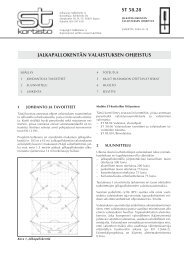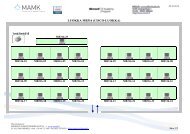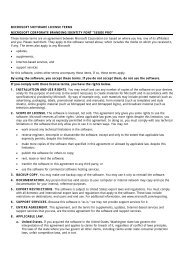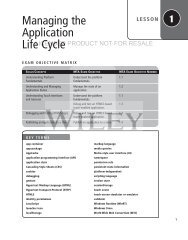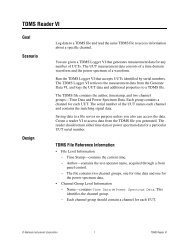Building the User Interface by Using HTML5: Organization ... - server
Building the User Interface by Using HTML5: Organization ... - server
Building the User Interface by Using HTML5: Organization ... - server
You also want an ePaper? Increase the reach of your titles
YUMPU automatically turns print PDFs into web optimized ePapers that Google loves.
56 | Lesson 3<br />
TAKE NOTE<br />
*<br />
As you learned in Lesson 1, <strong>the</strong> <strong>HTML5</strong> standard won’t be finalized for several years,<br />
which means changes to <strong>the</strong> specification are still occurring. The major Web browsers, like<br />
Microsoft Internet Explorer and Mozilla Firefox, support many <strong>HTML5</strong> elements but not<br />
all of <strong>the</strong>m. The “When Can I Use” Web site at http://caniuse.com/ is an excellent source<br />
for determining which browsers support specific <strong>HTML5</strong> features. The Web site is updated<br />
regularly, so you should make it a part of your essential <strong>HTML5</strong> resources. In addition,<br />
you can test any browser’s support for <strong>HTML5</strong> <strong>by</strong> browsing to <strong>the</strong> <strong>HTML5</strong> Test Web site<br />
at http://html5test.com.<br />
LICENSED PRODUCT NOT FOR RESALE<br />
Let’s look more closely at <strong>the</strong> <strong>HTML5</strong> tags shown in Figure 3-1, which are <strong>the</strong> most commonly<br />
used structure-related <strong>HTML5</strong> tags.<br />
THE HEADER AND FOOTER ELEMENTS<br />
The header element defines a header for a document, section, or article. In HTML 4.01,<br />
you use <strong>the</strong> header div as mentioned in <strong>the</strong> previous section (). The<br />
footer element defines a footer for a document or section, and typically contains information<br />
about <strong>the</strong> document or section, such as <strong>the</strong> author name, copyright data, links to related<br />
documents, and so on. The footer element doesn’t automatically appear at <strong>the</strong> bottom<br />
(or foot) of <strong>the</strong> document—you need to use CSS to instruct <strong>the</strong> browser where to display<br />
<strong>the</strong> footer. Footers that appear at <strong>the</strong> bottom of every Web page or document are known as<br />
“sticky footers.”<br />
An example of an article with a header tag and a footer tag is as follows:<br />
<br />
<br />
Learning <strong>HTML5</strong><br />
The New Elements<br />
<br />
New <strong>HTML5</strong> tags make Web page and application<br />
development easier than ever.<br />
<br />
Published:



